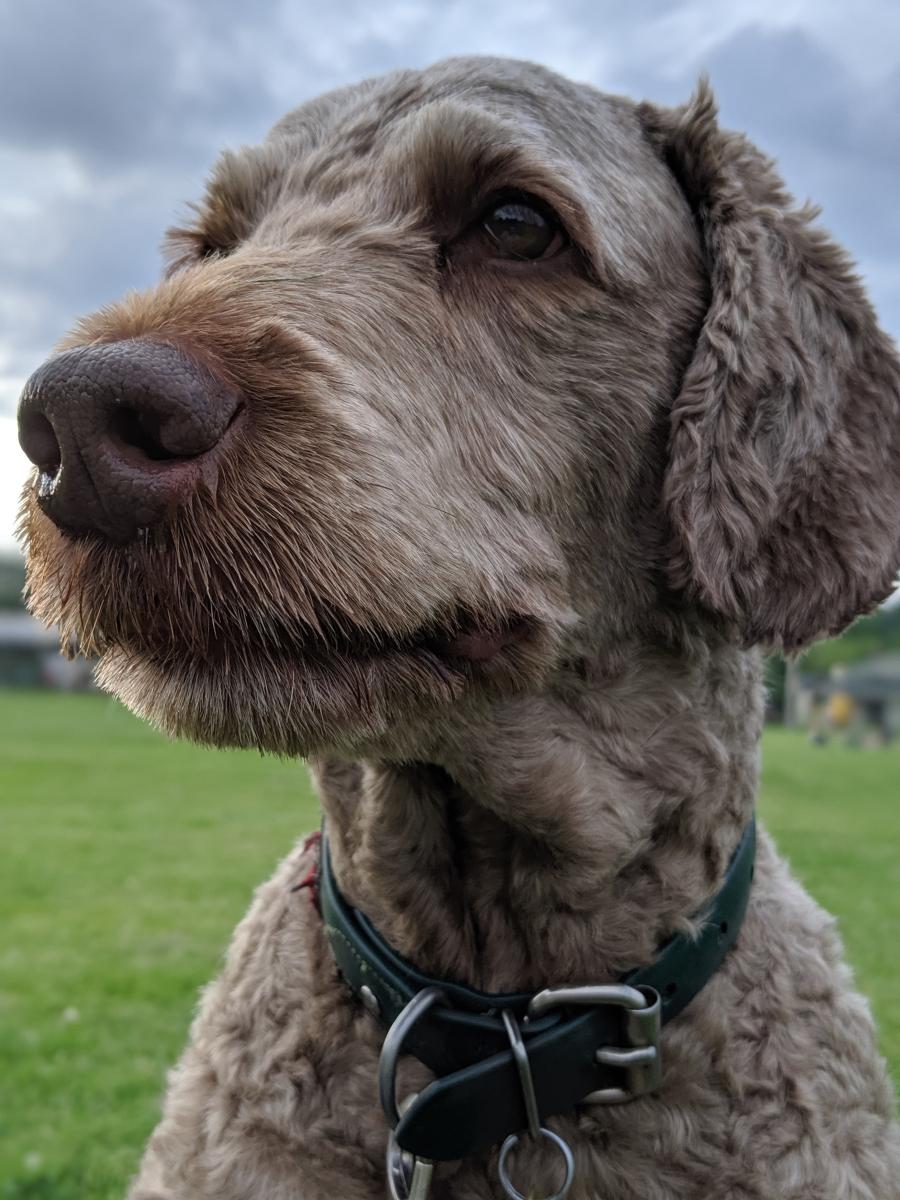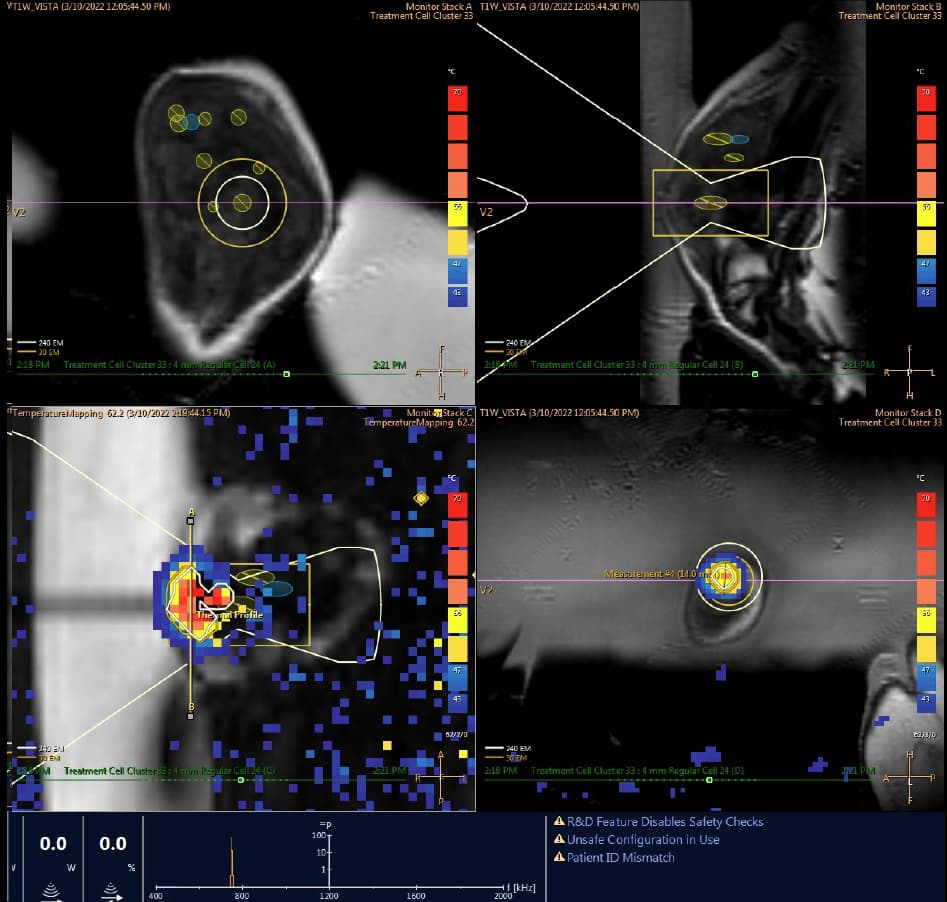Dr. Brigitte Brisson has teamed up with the SickKids Research Institute to explore a non-invasive treatment for canine bone cancer that may also benefit children.
 In 2022, George, a nine-year-old labradoodle, developed a tumour in his front leg. He was diagnosed with canine osteosarcoma - a type of bone cancer. His owners sought relief for their beloved companion, who experienced acute pain and lameness as a result of the lesion but was not a good candidate for amputation, the standard of care procedure for osteosarcoma.
In 2022, George, a nine-year-old labradoodle, developed a tumour in his front leg. He was diagnosed with canine osteosarcoma - a type of bone cancer. His owners sought relief for their beloved companion, who experienced acute pain and lameness as a result of the lesion but was not a good candidate for amputation, the standard of care procedure for osteosarcoma.
George was enrolled in an ongoing study funded by OVC Pet Trust at the Ontario Veterinary College (OVC) trialling the use of ultrasound technology to treat bone cancers. Five days after his first treatment, George was able to run and play without lameness. His story sparked hope and promise for this novel study – the first of its kind in Canada.
Canine appendicular osteosarcoma (OSA) is a bone cancer that affects the limbs of dogs. The most common of all canine bone tumours, OSA is typically seen in older, large- and giant-breed dogs over the age of eight.
Sadly, OSA has a poor prognosis: by the time tumours are visible on radiographs, the disease has usually spread (metastasized) to other areas of the body. 15 per cent of dogs diagnosed with OSA have lung metastasis at the time of diagnosis, and 90 per cent experience metastasis within one year of diagnosis.
Because of its metastatic nature, treatment for OSA is palliative rather than curative. In addition to pain management, the recommended treatment is amputation of the affected limb to address the painful lameness, followed by chemotherapy to attempt control of metastatic spread of tumour cells. Still, this aggressive treatment approach may only extend lifespan by two years in 20 per cent of dogs. Without amputation, most dogs typically live for two to six months because bone tumours are extremely painful and effective medical pain management can be challenging.
These disheartening realities have prompted the exploration of novel treatment approaches to better palliate dogs with appendicular OSA. Dr. Brigitte Brisson, a surgeon at OVC’s Companion Animal Hospital and a professor of soft tissue surgery, is leading the way.
Fighting Cancer with Ultrasound
 Brisson’s research and clinical expertise lies in the area of minimally invasive surgery (MIS) and interventional procedures. Currently, she is collaborating with medical professionals and researchers from The Hospital for Sick Children (SickKids) to trial a non-invasive treatment for canine appendicular OSA using High-Intensity Focused Ultrasound (HIFU) – the same treatment that benefitted George, the labradoodle. George was the first patient to enroll in Brisson’s study. Although he passed away of an unrelated condition after several months, the treatment dramatically reduced his pain and provided good quality of life during the remainder of his time with his family.
Brisson’s research and clinical expertise lies in the area of minimally invasive surgery (MIS) and interventional procedures. Currently, she is collaborating with medical professionals and researchers from The Hospital for Sick Children (SickKids) to trial a non-invasive treatment for canine appendicular OSA using High-Intensity Focused Ultrasound (HIFU) – the same treatment that benefitted George, the labradoodle. George was the first patient to enroll in Brisson’s study. Although he passed away of an unrelated condition after several months, the treatment dramatically reduced his pain and provided good quality of life during the remainder of his time with his family.
HIFU uses high-intensity ultrasound waves to destroy targeted cells in the body. HIFU can treat deep tissues minimally invasively and without the need for a skin incision, minimizing recovery time.
 Much like a magnifying glass is used to focus sunlight, HIFU is used to focus soundwaves onto a lesion. The targeted, high thermal energy from the ultrasound waves heats cancer cells, resulting in irreversible cell death. HIFU waves can be targeted to an area ranging from a few millimeters (the size of a grain of rice) to up to several centimeters (the size of a softball) with HIFU beam steering. Temperatures rise to above 60 degrees Celsius, where cell death typically occurs within seconds.
Much like a magnifying glass is used to focus sunlight, HIFU is used to focus soundwaves onto a lesion. The targeted, high thermal energy from the ultrasound waves heats cancer cells, resulting in irreversible cell death. HIFU waves can be targeted to an area ranging from a few millimeters (the size of a grain of rice) to up to several centimeters (the size of a softball) with HIFU beam steering. Temperatures rise to above 60 degrees Celsius, where cell death typically occurs within seconds.
Brisson and a team of clinical and research collaborators at SickKids use magnetic resonance imaging (MRI) to guide the delivery of HIFU treatment. MRI offers high-quality images of the bone structures and enables real-time thermal mapping of the body’s tissues to monitor tissue heating, ensuring cell death where desired and reducing the risk of overheating adjacent non-tumour tissues such as the overlying skin.
HIFU has been used infrequently in canines to treat a small number of soft tissue sarcomas, as well as hepatocellular adenoma (a type of benign liver tumour) and mast cell tumours. Brisson is the first researcher in Canada to trial HIFU on canine OSA patients and the first to trial it as a palliative option for canine patients that are not otherwise candidates for amputation.
“For some pets, amputation and chemotherapy are simply not possible,” says Brisson. “Pet parents may not wish to have their pet’s leg amputated and sometimes orthopedic conditions in other limbs preclude amputation as a treatment. In these instances, we’re looking for ways to better palliate pain and target existing cancer growth. By shrinking tumours with HIFU treatment, we can dramatically reduce a patient’s pain, which improves their mobility and overall quality of life.”
Benefits Beyond Tumour Reduction
In addition to directly killing cancer cells and shrinking tumours, HIFU may also stimulate the immune system in canine patients with OSA.
“HIFU treatment appears to promote an immunogenic stimulation effect known as an abscopal effect,” says Brisson. “The exact mechanism is not known, but when part of a tumour is killed but left in the patient like after HIFU, the immune system appears to be stimulated and this can slow or even stop the development of metastasis. We don’t know whether this translates in all tumours or all species, but the benefits for dogs with OSA could be significant.”
In this way, HIFU could also prove beneficial for dogs who are candidates for amputation. Administering HIFU prior to surgery may provide an immune system boost to help suppress further spread of OSA in the body.
Could HIFU Help Children with Similar Tumours?
MRI-guided HIFU has been used in humans for several years to treat soft tissue tumours, such as uterine fibroids and prostate cancer. More recently, it has been used at SickKids to treat certain types of benign bone tumours, called osteoid osteoma, in children as young as seven years old.
Because OSA is genetically similar in dogs and humans, Brisson and SickKids researchers seek to understand whether HIFU could also be used in pediatric patients diagnosed with cancerous tumours.
“There is translational potential for this research,” says Brisson. “We know that OSA manifests similarly in children as it does in dogs. So, could we take the knowledge we gain from our canine studies and apply it to benefit children in the future? OSA is an incredibly painful, life-threatening disease. It’s worth exploring.”
What’s Next?
 Brisson and the team at SickKids have welcomed another dog into the study since George passed away, and SickKids scientists hope to use the study to inform future research. Recruitment remains open for dogs who may benefit from HIFU, both prior to amputation and as a palliative treatment for pain.
Brisson and the team at SickKids have welcomed another dog into the study since George passed away, and SickKids scientists hope to use the study to inform future research. Recruitment remains open for dogs who may benefit from HIFU, both prior to amputation and as a palliative treatment for pain.
“Currently, we’re approaching MRI-guided HIFU treatment as a palliative option for dogs with OSA, but we can’t say with certainty that palliation will always be the end-goal,” says Brisson. “Could HIFU offer a therapeutic or curative treatment option in the future? Our early results are promising. Only time will tell.”
To learn more about Brisson’s study and how to participate, please email ovc.clinicaltrials@uoguelph.ca or visit the OVC Clinical Trials website.
This story was originally published in Best Friends magazine (Spring/Summer 2024). Written by Becky Rothwell
Story images:
- George the labradoodle
- An MRI image displaying thermal mapping indicating treated vs. untreated cells1
- George the labradoodle is positioned for HIFU treatment. Photo by Ashleigh Martyn.
- George and his owner, Jelena
1. Brisson B., Waspe A.C., Wong S., den Otter-Moore I., Kerr C., Macsemchuk C., Sin V., Temple M.J., Drake J.M., “Magnetic resonance-guided high intensity focused ultrasound (MRgHIFU) to treat canine appendicular osteosarcoma: Preliminary results”, 8th International Symposium on Focused Ultrasound, Bethesda, MD: Oct. 23-27, 2022 (oral).

